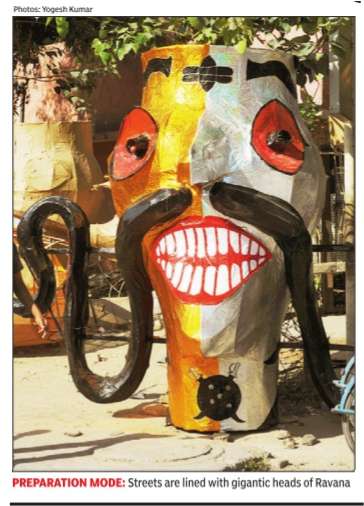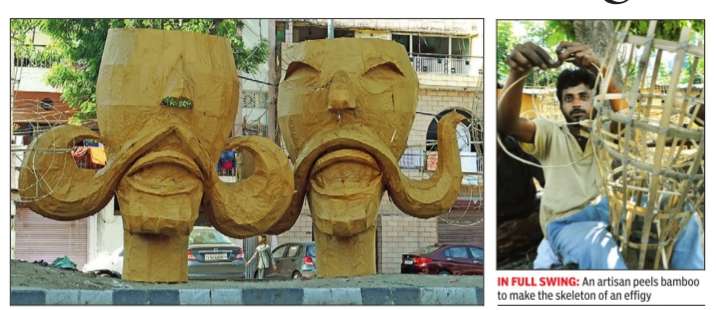Delhi: T
| Line 15: | Line 15: | ||
Almost 20 acres exclusively for CPWD’s nursery functions Central axis inspired by the Persian carpet design with fountains, sandstone lights all carved with hand in true Mughal style A number of Mughal monuments can also be found | Almost 20 acres exclusively for CPWD’s nursery functions Central axis inspired by the Persian carpet design with fountains, sandstone lights all carved with hand in true Mughal style A number of Mughal monuments can also be found | ||
| + | |||
| + | =Titarpur= | ||
| + | [http://epaperbeta.timesofindia.com/Article.aspx?eid=31808&articlexml=In-demon-king-Ravana-Titarpur-artisans-find-their-08102015006040 ''The Times of India''], Oct 08 2015 | ||
| + | [[File: Titarpur.jpg|Picture courtesy: [http://epaperbeta.timesofindia.com/Article.aspx?eid=31808&articlexml=In-demon-king-Ravana-Titarpur-artisans-find-their-08102015006040 ''The Times of India''], Oct 08 2015|frame|500px]] | ||
| + | [[File: Titarpur1.jpg|Picture courtesy: [http://epaperbeta.timesofindia.com/Article.aspx?eid=31808&articlexml=In-demon-king-Ravana-Titarpur-artisans-find-their-08102015006040 ''The Times of India''], Oct 08 2015|frame|500px]] | ||
| + | |||
| + | Dharvi Vaid | ||
| + | |||
| + | ''' In demon king Ravana, Titarpur artisans find their god ''' | ||
| + | |||
| + | For about a month before Dussehra, the streets of Titarpur in West Delhi are lined with tall, intricately-woven bamboo frames, and gigantic heads of Ravana made using papier-mâché. Artisans are seen peeling bamboo, using its wicker to make the skeleton of the “demon king“. But on Dussehra, when the whole country revels as these effigies are burnt, gloom descends on Titarpur. | ||
| + | Being one of the largest efigy markets in the country with a 40-year-old history ,Titarpur “worships“ Ravana. Indebted to their “hero“, the craftsmen here believe that he is a source of their livelihood; the art has perked up the area's economy. | ||
| + | Local legend has it that an old man, “Ravanawaale baba“, came to the area about 40 years ago from Sikandrabad in Uttar Pradesh and started selling articles used in funerals. Gradually , he got into the art of effigy making. When he sat with bamboo sticks, weaving frames, children got fascinated and learnt the art watching him. Ever since, every inhabitant of the area, rom ironsmiths to food stall owners, took to the craft. | ||
| + | Sixty-year-old RajendraKashyap claims that he learnt he craft from “Ravanawaale baba“ at the age of six. “I, too, was curious about his art. I never knew what I learnt play ully would become my profession,“ he says. | ||
| + | “I started making effigies o support my huge family .Iniially, there weren't many craftsmen in the area, so money came in easily .Gradually ,I saved enough to set up a food stall near a Metro station,“ he says. | ||
| + | Among the oldest effigy makers around, Kashyap has never celebrated Dussehra.He stays back at home when he effigies of Ravana are set on fire as he “cannot see them burning“. “It feels like a fam ly member burning. Had Ravana not been there, I wonder what my financial state would have been? I begin my day by aking his name,“ he says. | ||
| + | Kamal Kumar makes efigies as it is a family legacy “My father and uncles were in o the effigy-making business As a kid, I saw them painting colourful papier-mâché faces and learnt the art from them,“ says Kamal. One can find this 35-year-old electrical engineer conversing with his custom ers in English. | ||
| + | The craft earned him enough to support his education after his father's death Every Dussehra, he and his brother make limited number of effigies mostly for schools “They order effigies five to 50 feet tall,“ he says. | ||
| + | Rahul Kumar, a cab driver doubles as an effigy maker to have an extra source of in come. Associated with an e commerce company | ||
| + | These craftsmen start making effigies two months before Dussehra. Whereas bamboo is brought from mar kets in Delhi and UP , paper and glue are purchased from Sadar Bazaar. Artisans start with making hands and legs, keeping the bust and the head for the last. “Eyes are the most important part. They have to look ferocious to give the effigy an intimidating appearance,“ says Kashyap. | ||
| + | |||
| + | Most effigies are 25 to 50feet tall and cost Rs 200 per foot. They also get orders from abroad. Sellers say they net 30% to 40% profit, but fear rising cost of raw materials might reduce this margin. | ||
Revision as of 06:27, 9 October 2015
This is a collection of newspaper articles selected for the excellence of their content. |
CITY’S TREE SANCTUARY
Together with Delhi zoo, Purana Qila, Millennium Park and Humayun’s Tomb, the nursery stands in an uninterrupted Mughal landscape spanning more than 1,000 acres More than 1,800 mature trees of over 200 species at the nursery recorded on a geographic information system (GIS). Hundred more species planted Biodiversity studies conducted by AKTC in 2012 documented 54 species of resident birds and 24 species of butterfl ies
Almost 20 acres exclusively for CPWD’s nursery functions Central axis inspired by the Persian carpet design with fountains, sandstone lights all carved with hand in true Mughal style A number of Mughal monuments can also be found
Titarpur
The Times of India, Oct 08 2015


Dharvi Vaid
In demon king Ravana, Titarpur artisans find their god
For about a month before Dussehra, the streets of Titarpur in West Delhi are lined with tall, intricately-woven bamboo frames, and gigantic heads of Ravana made using papier-mâché. Artisans are seen peeling bamboo, using its wicker to make the skeleton of the “demon king“. But on Dussehra, when the whole country revels as these effigies are burnt, gloom descends on Titarpur. Being one of the largest efigy markets in the country with a 40-year-old history ,Titarpur “worships“ Ravana. Indebted to their “hero“, the craftsmen here believe that he is a source of their livelihood; the art has perked up the area's economy. Local legend has it that an old man, “Ravanawaale baba“, came to the area about 40 years ago from Sikandrabad in Uttar Pradesh and started selling articles used in funerals. Gradually , he got into the art of effigy making. When he sat with bamboo sticks, weaving frames, children got fascinated and learnt the art watching him. Ever since, every inhabitant of the area, rom ironsmiths to food stall owners, took to the craft. Sixty-year-old RajendraKashyap claims that he learnt he craft from “Ravanawaale baba“ at the age of six. “I, too, was curious about his art. I never knew what I learnt play ully would become my profession,“ he says. “I started making effigies o support my huge family .Iniially, there weren't many craftsmen in the area, so money came in easily .Gradually ,I saved enough to set up a food stall near a Metro station,“ he says. Among the oldest effigy makers around, Kashyap has never celebrated Dussehra.He stays back at home when he effigies of Ravana are set on fire as he “cannot see them burning“. “It feels like a fam ly member burning. Had Ravana not been there, I wonder what my financial state would have been? I begin my day by aking his name,“ he says. Kamal Kumar makes efigies as it is a family legacy “My father and uncles were in o the effigy-making business As a kid, I saw them painting colourful papier-mâché faces and learnt the art from them,“ says Kamal. One can find this 35-year-old electrical engineer conversing with his custom ers in English. The craft earned him enough to support his education after his father's death Every Dussehra, he and his brother make limited number of effigies mostly for schools “They order effigies five to 50 feet tall,“ he says. Rahul Kumar, a cab driver doubles as an effigy maker to have an extra source of in come. Associated with an e commerce company These craftsmen start making effigies two months before Dussehra. Whereas bamboo is brought from mar kets in Delhi and UP , paper and glue are purchased from Sadar Bazaar. Artisans start with making hands and legs, keeping the bust and the head for the last. “Eyes are the most important part. They have to look ferocious to give the effigy an intimidating appearance,“ says Kashyap.
Most effigies are 25 to 50feet tall and cost Rs 200 per foot. They also get orders from abroad. Sellers say they net 30% to 40% profit, but fear rising cost of raw materials might reduce this margin.